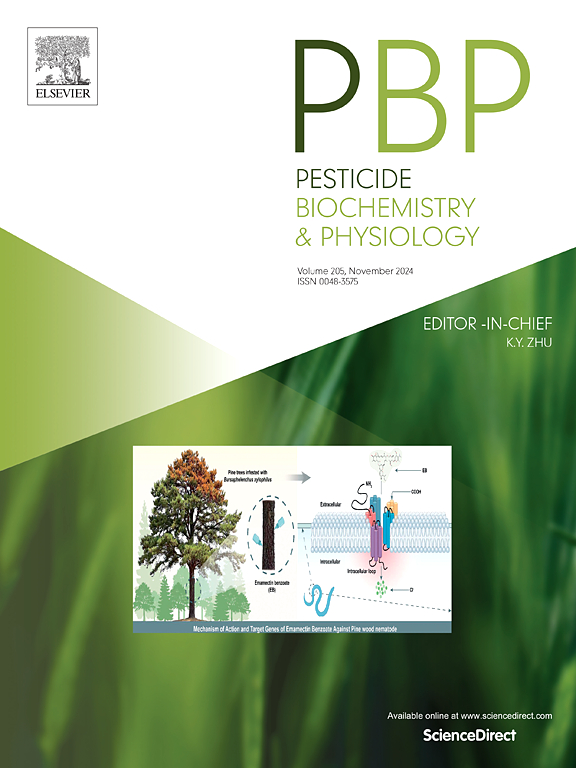7-Hydroxylathyrol defeats geminivirus through targeting C4 and activating host defense
IF 4.2
1区 农林科学
Q2 BIOCHEMISTRY & MOLECULAR BIOLOGY
引用次数: 0
Abstract
Tomato yellow leaf curl virus (TYLCV), which belongs to Geminiviruses, is a notorious plant virus that poses a threat to global agriculture. 7-Hydroxylathyrol is a renowned lathyrane diterpenoid with a broad spectrum of pharmacological activities. However, its efficacy against plant pathogens remains unknown. In this study, we investigated the antiviral activity of 7-hydroxylathyrol against TYLCV and explored the molecular mechanisms underlying its antiviral effects. 7-Hydroxylathyrol significantly disrupted TYLCV and inhibited its accumulation in Nicotiana benthamiana. To explore the mechanism of 7-hydroxylathyrol against TYLCV, proteins encoded by TYLCV were purified, and their interactions with 7-hydroxylathyrol were studied. Biolayer interferometry and pull-down experiments showed that 7-hydroxylathyrol bound to C4 with a dissociation constant of 6.50 × 10−8 M, while it could not bind to other viral proteins. Moreover, 7-hydroxylathyrol inhibited gene expression and protein accumulation of C4 in N. benthamiana, and the infectious clone TYLCV(ΔC4), which contains a nontranslatable C4, weakened the inhibitory effect of 7-hydroxylathyrol against the virus. Furthermore, molecular docking and point mutation analyses were implemented, and results indicated that the specific R37 and T38 of C4 were critical for the interaction between 7-hydroxylathyrol and C4. In addition, 7-hydroxylathyrol could inhibit another geminivirus, tobacco curly shoot virus (TbCSV), which also possessed these two conserved sites. At last, we found that 7-hydroxylathyrol enhanced the plant defense capacity by increasing the activity of defense enzymes and upregulating the expression of pathogenesis-related genes. These results demonstrated that 7-hydroxylathyrol possessed a dual antiviral mechanism of binding TYLCV C4 and activating plant defense responses. This study provided key insights for designing novel plant geminivirus inhibitors.
7-羟乙基醇通过靶向C4并激活宿主防御来击败双病毒
番茄黄卷叶病毒(TYLCV)是一种危害全球农业的恶名昭著的植物病毒,属于双病毒。7-羟基lathyrol是一种著名的lathyrane二萜,具有广泛的药理活性。然而,其对植物病原体的作用尚不清楚。在本研究中,我们研究了7-羟乙基醇对TYLCV的抗病毒活性,并探讨了其抗病毒作用的分子机制。7-羟乙基醇显著破坏TYLCV并抑制其在烟叶中的积累。为了探究7-羟基乙基醇对抗TYLCV的作用机制,纯化了TYLCV编码的蛋白,并研究了它们与7-羟基乙基醇的相互作用。生物层干涉和下拉实验表明,7-羟乙基醇与C4结合的解离常数为6.50 × 10−8 M,而不能与其他病毒蛋白结合。此外,7-羟乙基醇抑制了benthamiana中C4基因的表达和蛋白质的积累,并且含有不可翻译C4的感染克隆TYLCV(ΔC4)削弱了7-羟乙基醇对病毒的抑制作用。通过分子对接和点突变分析,发现C4的特异性R37和T38是7-羟乙基醇与C4相互作用的关键基因。此外,7-羟乙基醇还能抑制同样具有这两个保守位点的烟草卷枝病毒(TbCSV)。最后,我们发现7-羟乙基醇通过增加防御酶的活性和上调致病相关基因的表达来增强植物的防御能力。这些结果表明,7-羟乙基醇具有结合TYLCV C4和激活植物防御反应的双重抗病毒机制。该研究为设计新型植物双病毒抑制剂提供了重要见解。
本文章由计算机程序翻译,如有差异,请以英文原文为准。
求助全文
约1分钟内获得全文
求助全文
来源期刊
CiteScore
7.00
自引率
8.50%
发文量
238
审稿时长
4.2 months
期刊介绍:
Pesticide Biochemistry and Physiology publishes original scientific articles pertaining to the mode of action of plant protection agents such as insecticides, fungicides, herbicides, and similar compounds, including nonlethal pest control agents, biosynthesis of pheromones, hormones, and plant resistance agents. Manuscripts may include a biochemical, physiological, or molecular study for an understanding of comparative toxicology or selective toxicity of both target and nontarget organisms. Particular interest will be given to studies on the molecular biology of pest control, toxicology, and pesticide resistance.
Research Areas Emphasized Include the Biochemistry and Physiology of:
• Comparative toxicity
• Mode of action
• Pathophysiology
• Plant growth regulators
• Resistance
• Other effects of pesticides on both parasites and hosts.

 求助内容:
求助内容: 应助结果提醒方式:
应助结果提醒方式:


